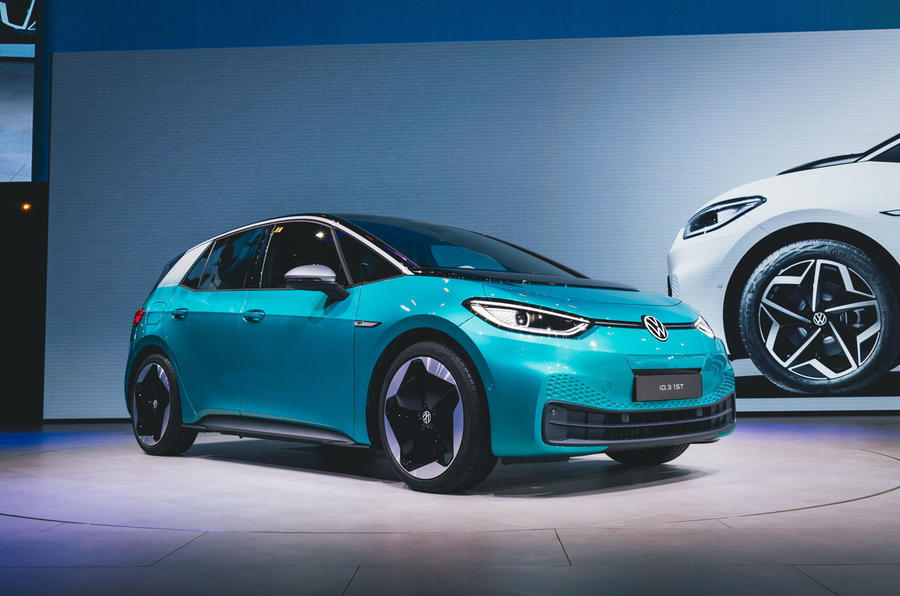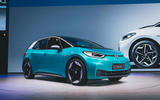Hedging is normally a phrase used to describe offsetting risk in a financial deal. But it’s emerging at Frankfurt as one of the major techniques deployed to help the car industry cope with the switchover to electric models – whose customer demand is as yet unclear.
In the car industry's case, the ‘hedging’ refers to keeping two models on sale to cover the same market segment – one with internal combustion engines (ICE) and one with electrified powertrains.
Porsche, for example, is planning an new all-electric SUV, based on the new PPE platform co-developed with Audi, that it refers to as the "all-electric Macan". It's due to go on sale around 2022.
But it also plans to keep another Macan on a conventional platform, powered by petrol and diesel engines, on sale for markets where demand for electrification is forecast to be low.
Volkswagen is doing the same with the Volkswagen Golf and ID 3. At Frankfurt, the marketing focus is on the ID 3, a five-door five-seat 4m-long family hatchback with an electric powertrain.
It will be aimed at the same people who might also be expected to be in the market for a Golf. However, in many markets, the ID 3 will be too expensive and not required by legislation, so VW is also locked in to replacing its iconic Golf.
In the UK, the Golf Mk8 will go on sale in early summer, about a month before the first ID 3 models are delivered to customers. It is too risky for VW to replace the Golf with an electric model only, so it has to hedge and offer both.
The same is happening at Mercedes, which showed a sleek, low and rounded large saloon, the EQS, which is an all-electric flagship four-door that will offer many of the functions of the Mercedes-Benz S-Class.
However, there will still have to be a regular S-Class, a more formal and traditional luxury saloon for markets that are not ready for a pure-electric luxury saloon.
Given that model lifecycles in the car industry are usually around eight years, that’s the timescale over which consumers and the market might substantially flip towards electrification – by around 2030 – giving the industry breathing space to decide if the next generations of models can fully abandon combustion power. It’s a practical solution, but an expensive one.










Join the debate
Add your comment
The vast majority
"vast majority of journeys" is not the answer, Brian. My current car does all of my journeys. You don'r catch planes or trains to get to your destination the vast majority of times. You don't buy a phone to be able to make or take a call the vast majority of times. You don't order food at a restaurant to enjoy it the vast majority of times. When you go to your supermarket you don't expect to be able to buy stuff the vast majority of times.
That "vast majority of journeys" is what has unfortunately killed spare wheels in the first place. The vast majority of times - heck, almost all of the time - you don't need one. But when you do need one, you need one. Period.
It needs to work. Period.
I drive on vacation to Sardinia, where it's rural and I go to the beach and the charging infrastructure is zilch, 6 or 7 weeks per year. Some 2000-3000 km overall.
The rest of the year I would probably - "the vast majority of journeys" - be fine with an EV. But would I be able to live my life just as I do now with a Diesel? No, there would be an impact. Does it make sense for me (or for the environment) to have two cars instead of one? No. If I had two cars, one of them would probably be an EV. But I only have one so it can't be an EV.
Oh, and I do have a full size spare wheel (plus the one around the waist).
"Backwater" - Torque Stear!!
Sicily has a population of over 5 million and gets over 15 million visitors a year. And you call it a backwater! You do know that it's part of Italy? In fact it's only 2 miles from the mainland!
And my point was: that the reason that car manufacturers will not be stopping the production of ICE cars anytime soon, is because you still cannot do something simple in an EV, such as picking up a hire car at a very popular tourist desitination in Italy, and go on a driving holiday for a couple of weeks in an EV.
What I did wasn't unique. It's what the majority of the 15 million tourists will do, judging by the number of hire cars at the airport. You can do it quite easily in a ICE car. It would be basically impossible, or inconvenient to the point of it being essentially impossible/pointless, in an EV.
And the mobile phone analogy is a poor one. Mobile phones were something new. An EV is just a different way of powering something that already exists, and at the moment, in a manner that makes the existing product do less than it did before.
I think Autocar need to spend more time in the real world!
I recently took a driving tour of Sicily, in a diesel hire car. I drove nearly 2000 kms and stayed at 8 different 4 and 5* hotels. Only one of them had an electric car charging point in the car park, and that was blocked by a non-electric car, as, incidentally was the disabled space, by a non-disabled motorist. People simply have no respect.
3 of the hotels had no parking whatsoever, which meant public car parks, some distance away. I saw not one public electric car charging point in Sicily - an island, where you have to be careful at petrol stations, because they would like you to use the attended pumps, where they charge you between 20 and 40 cents per litre for the privilege of them refuelling your car!
Had I been in an EV, perhaps the hotel with the point would have tracked down the owner of the car blocking it, and I could have used it, assuming that it was compatible, and worked.
Perhaps the other 4 hotels would have had sufficient extension cables, and would have been happy to have them trailing across the car-park to my EV, but I wouldn't want to bet on it.
And the 3 with no parking?
Do I want to spend my holiday with range anxiety, or with flat batteries in the mountains, in the middle of nowhere? And what would the range of an EV be in Sicily? The average economy on the car was about 4.5 litres per 100 km. On a mountain pass, the consumption was anywhere from double to triple that!
"Manufacturers won't ditch ICE models yet". You can count on that Mr Rendell!
Real world LucyP?
Real world LucyP?
None of what you describe is a typical daily driving experiance, you went on a driving holiday in a back water location.
You anecdote is pretty similar to saying 20 years ago, "mobile phones are clearly going nowhere, I went to Scilly, they have no cell towers and the signal is terrible there".
EV's are fully suitable for the 50% of the population have off road parking on a drive, that population of users also have an average commute of less than 20 miles.
That market (30 million Uk alone) is big enough to drive the demand that will result in the required infrastructure being built that will allow everyone else to adopt. Much in the same way that any electrical capacity improvements will simply be paid for as part of the cost of the electiricity.